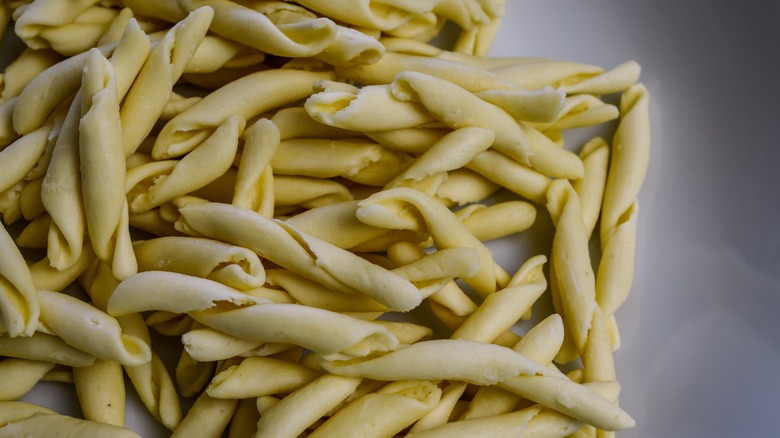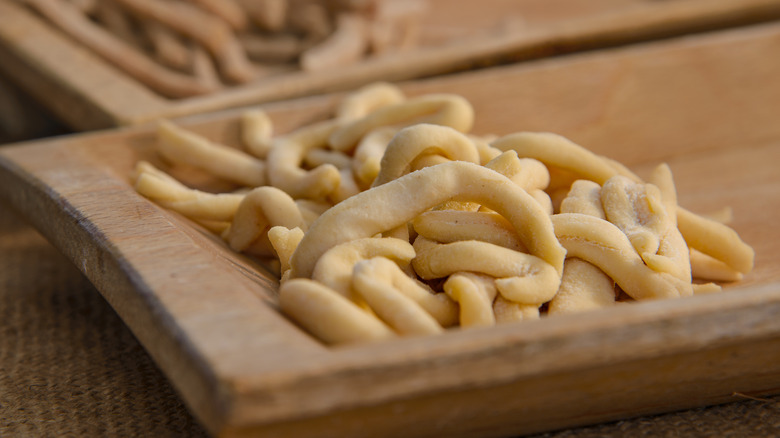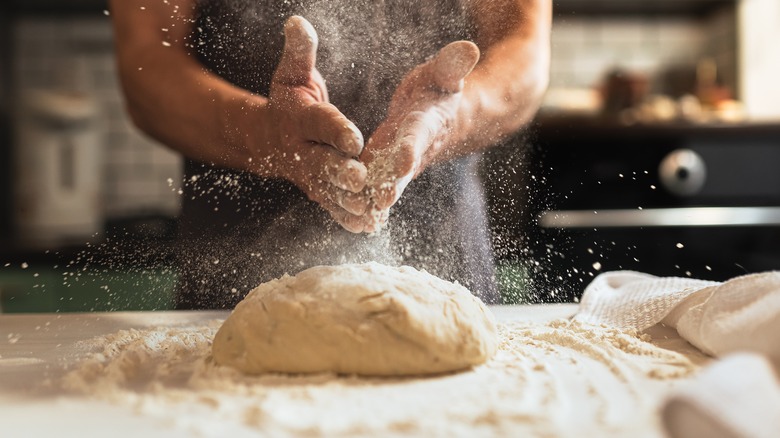The Italian Pasta Named After A Choking Priest
According to Parade, there are approximately 600 different kinds of pasta out there, each of which has its own unique purpose. For example, the flat, wide shape of fettuccine in fettuccine alfredo helps the pasta retain a thick, delicious coating sauce, while the shape of tortellini — complete with a natural ring-shaped pocket — is perfect for stuffing with meat or cheese. There are also some less common pasta selections, such as ditalini, which is ideal when used in soups thanks to its short, cylindrical shape, and orecchiette, a pasta most commonly accompanied by a seafood hero, whose name translates to "ear."
When it comes to the origins of pasta in all its variations, PBS explains that pinning down the specifics is quite challenging. While pasta noodles are uniquely Italian due to the use of durum wheat, which has a higher gluten content, the dish has roots in ancient Asia. Despite claims that explorer Marco Polo was the first to introduce noodles to Italy, evidence suggests Italians were already enjoying the food long before his trek. The word pasta translates to "paste" in English, which points to the components needed to make dough for pasta (namely, flour and water). As for where individual types of pasta get their names, one variety, in particular, has a rather shocking moniker and back story.
Italian villagers fight injustice with pasta
As explained by news.com.au, strozzapreti is penne-like and fashioned into twists, with a pasta shape similar to rope. It's believed to have originated at some point in the 1600s when the Papal States, or Italian territories that were ruled by the Pope, were in power. During this period, priests and bishops were akin to ruling lords, who felt no qualms about taking what they wanted from salt-of-the-earth folks such as farmers and innkeepers. Their rule was so oppressive that Italian peasants cursed their very existence. This led to the creation of strozzapreti, also known as "priest-stranglers" in English.
While the Italian women who cooked in taverns and inns had no choice but to serve these "ravenous lords" when they came calling, they certainly weren't happy about it. As a result, many uttered the refrain "mannaggia a te, mannaggia a te" as they twisted dough into the notable strozzapreti form, which roughly translates to "thou be damned." The hope was that the greedy priest who was wreaking so much havoc on average people would choke while voraciously slurping down his meal.
While tales abound of this very thing happening, there's no real evidence that any priests were actually harmed while dining on strozzapreti. All things considered, the fact that the story behind strozzapreti seems more apocryphal than not is definitely a relief for people who want to enjoy the dish today.
How to create strozzapreti like a pro
There's nothing more satisfying than making your own pasta at home, especially a variety with such a rich and interesting history as strozzapreti. MasterClass offers a few tips to those enterprising individuals who prefer the DIY route. First, it's recommended that you use a scale to weigh ingredients before incorporating them into the dough, which ensures a pleasing and consistent texture. After the ingredients have been combined and the dough has been kneaded, let it rest for a while to ensure easy workability. And as you're creating individual strozzapreti noodles, cover the remaining dough in plastic to keep it moist.
You should also consider what type of sauce you'd like to dress your strozzapreti with. Basil pesto is ideal for a fresh and flavorful dish, while Bolognese sauce imbues the pasta with so much meaty goodness. When in doubt, tasty tomato sauce is just the thing to create a wholesome and delicious meal. One of the great things about strozzapreti is its versatility, which means it pairs beautifully with all sorts of recipes. Just be careful about how fast you eat it, lest you share the same fate as an insatiable 17th-century priest.


